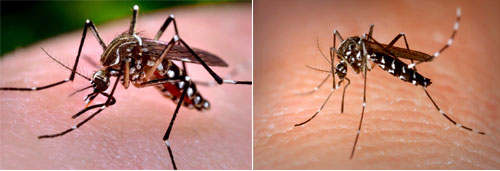Invasive Aedes Mosquitoes
Two invasive (non-native) mosquito species have spread to several California cities, and there is the potential for them to become established in Ventura County. Since 2014, the Vector Control Program has deployed specially designed traps at various locations to monitor for the presence of Aedes aegypti and Aedes albopictus. The first detection of Aedes aegypti occurred in early September 2020 in Simi Valley.
Unlike most native mosquito species, Aedes aegypti and Aedes albopictus commonly bite during the day. Both species are small black mosquitoes with white stripes on their back and on their legs. They can be found inside and outside houses and buildings. They can lay eggs in any small artificial or natural container or surface that holds as little as a teaspoon of water. Common items like potted plant saucers, rain barrels, bird baths, tires, and equipment can be used as development sites by the larvae of these mosquitoes. Eggs are laid on dry surfaces and hatch later when water contacts them. Eggs stay dry for a year or more and still hatch out later. The average lifespan of an adult is around two weeks.
Aedes aegypti and Aedes albopictus have the potential to transmit several viruses, including dengue, chikungunya, Zika virus, and yellow fever. Thousands of people are infected with these viruses in other parts of the world, including Mexico, Central and South America, the Caribbean, and Asia. If a traveler is infected and returns to or visits our area and Aedes aegypti or Aedes albopictus are present, there is potential for these diseases to be spread here.
Click Here for an interactive map of confirmed detections of Aedes aegypti and approximate areas of infestation in Ventura County (updated as additional detections are made).
Disclaimer: This map was created by the Ventura County Resource Management Agency Information Systems GIS, which is designed and operated solely for the convenience of the County and related public agencies. The County does not warrant the accuracy of this map and no decision involving a risk of economic loss or physical injury should be made in reliance therein.
Click Here For an Interactive Map of Invasive Aedes Detections in California (updated monthly)
The following map from the Vectorborne Disease Surveillance System shows the presence or absence of three Invasive Aedes species in California based on trapping results. Red areas have had the selected species trapped within them. Green areas have had trapping conducted with none of the selected species caught. Any new results of mosquito surveillance entered into the VectorSurv Gateway are updated within 24 hours.
- Mosquito Source Checklist Home Inspection (PDF) – September 2020
To protect yourself, your family, and the community from mosquitoes:
Eliminate standing water in and around your home
- Prevent runoff which accumulates in drains and gutters by avoiding overwatering and excessive use of water for other purposes.
- Cover yard drains with permeable landscape cloth or tight mesh screen and keep outlets clear.
- Once a week, empty and scrub, turn over, cover, or throw out items that hold water inside and outside your home.
- Tightly cover water storage containers (buckets, cisterns, rain barrels) so that mosquitoes cannot get inside to lay eggs.
- For containers without lids, use wire mesh with holes smaller than an adult mosquito.
- Keep rain gutters free of debris.
- Fill saucers under plants with sand or remove them.
- Remove bromeliads and other water holding plants from your landscape.
If you have a septic tank, follow these steps
- Repair cracks or gaps.
- Cover open vent or plumbing pipes.
- Use wire mesh with holes smaller than an adult mosquito
If you are being bitten by small black mosquitoes with white stripes in or around your home, especially during daylight hours, please call the Vector Control Program’s Mosquito Complaint Hotline at (805)658-4310.
To request free mosquito fish to control mosquito breeding in ponds, fountains, and water gardens call (805)662-6582.
For more information, check out California Department of Public Health, Aedes aegypti and Aedes albopictus Mosquitoes.


